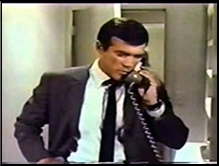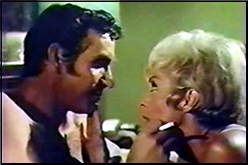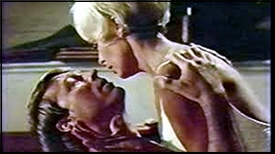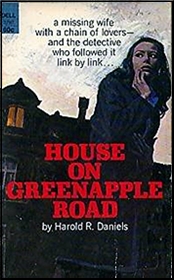REVIEWED BY DAN STUMPF:

FRIEDRICH DÃœRRENMATT – The Judge and His Hangman. Originally published in 1950 in German as Der Richter und sein Henker. First published in English by Jenkins (UK, hardcover, 1954). First US edition: Harper & Brothers, hardcover, 1955. Also published as End of the Game. Warner, 1976.
END OF THE GAME. Germany, 1975. Original title: Der Richter und sein Henker. Also released as Murder on the Bridge, Deception, Getting Away with Murder and The Monster That Devoured Cleveland. Jon Voight, Jacqueline Bisset, Robert Shaw, Lil Dagover, Friedrich Durrenmatt, Donald Sutherland and Pinchas Zuckerman. Screenplay by Friedrich Durrenmatt and Maximilian Schell. Directed by Maximilian Schell.
I read Friedrich Durrenmatt’s The Judge and His Hangman back in the mid-1970s and again about 20 years ago, but early this year an attack of severe and prolonged acid reflux recalled it to mind and I thought I’d have another look and maybe check out the film made from it.

Well, it’s pretty good. Ably constructed, well-translated (see Francis Nevins’ comments on the translation here ) with memorable characters and a tricky plot, plus that little something extra one always looks for in a mystery, and so seldom finds: the quirky element that makes a book stay in the memory and tug at the sleeve of your thoughts every now and again.
As Judge starts, Police Inspector Barlach has been on the trail of a Master Criminal named Gastmann for 40 years. Barlach is prematurely old, in pain, and dying of gastritis. He’s also a slow, methodical cop, considered old-fashioned by his subordinates, superiors, and especially by the object of his pursuit, Gastmann.
Barlach has set his best officer on the job of catching Gastmann, and that officer is found dead on the first page. Frustrated, in more pain than ever, Barlach puts his second-best man on the job, only to have Gastmann run circles around him. As the book progresses, Barlach becomes little more than a pathetic stooge for his brilliant nemesis, as the master thief plunders his files, disrupts his work, invades his home and even spirits him away at one point, all with the suave nonchalance and impudent ease of…

That’s when it hit me that this relationship was eerily like that of The Saint and his frequent foil, Inspector Teal. Gastmann describes himself as “an adventurer roaming the world… driven to taste life to the very last drop….†and he sums things up to Barlach, “…I was always one step ahead of you. Time and again I turned up in your career as a gray spectre. Time and again I was tempted to commit, under your very nose, the boldest, wildest crimes, and time and again you were unable to prove them.â€
Yeah, that’s the Saint and Mr. Teal, all right, and as I remember, Teal used to complain of indigestion a lot.

But this is a darker, more sardonic view of the relationship, and late in the book, when Barlach finds himself outsmarted once again, there’s a stunning moment when he turns to Gastmann and says, “I have judged you and condemned you to death. You will not survive the day. The hangman I have chosen for you will come for you today. You will recognize him. And he will kill you.â€
And from that point, it moves to a truly chilling climax, capped off by a scene so quirky and unsettling, I found myself re-reading it with genuine pleasure. This is one I mean to come back to, even if it takes another quarter-century. If my tattered paperback lasts that long. Or I do.

Any movie that features Donald Sutherland as a corpse is bound to be idiosyncratic, and End of the Game is rewardingly so. Stylishly directed, with off-beat casting and a cinematic script courtesy of author Durrenmatt (who plays himself in the film) and director Schell.
The U.S. release is dubbed, not always well, but has been capably translated — they persist in referring to small semi-automatic handguns as “revolvers†but that’s in the book too, and for all I know may be in the original German text. At least they stick to Durrenmatt’s dialogue. Also, for some reason, Ennio Morricone’s original score was replaced by some of his older compositions.

Despite this, Durrenmatt & Schell capture that “something extra†perfectly, with images that evoke the author’s word-paintings in colors delicate but vivid. The pacing is fast, and the twists and turns of the plot conveyed visually where it suits best. The scene where the executioner calls on Gastmann crackles with tension and explodes in violence with the kind of flair one sees in Don Siegel and Gordon Douglas at their best.
As for the actors, Friedrich Durrenmatt seems miscast, but Robert Shaw is dashingly sinister as the master criminal, Jon Voight sharp-eyed and ruthless, and Jacqueline Bisset gives her all to a complex and well-written part. But the big surprise is Martin Ritt as Barlach.
Ritt did some acting in the early days of television, but only rarely thereafter, and as far as I know, this was his only leading part. And he’s perfect. He plods around looking like a plump Percy Dovetonsils, pot-bellied, phlegmatic and bespectacled, but radiating an innate intelligence that lets us know immediately that this is no Dumb Cop.
This is not an easy film to find. It took me a month to get a copy in English from a dealer in the Czech Republic, but I have to say it was well worth the effort.



